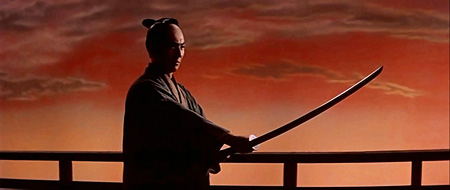
SAMURAI VENDETTA kicks off Monthly Classics series at Japan Society
SAMURAI VENDETTA (A CHRONICLE OF PALE CHERRY BLOSSOMS) (HAKUOKI) (Kazuo Mori, 1959)
Japan Society
333 East 47th St. at First Ave.
December 11 – May 14
Tickets: $15 for opening night, $11 thereafter
212-715-1258
www.japansociety.org
 When local official Tange Tanzen (Raizo Ichikawa) comes upon a battle between two schools of sword fighting, including his own, he chooses not to get involved as rogue samurai Yasubei Nakayama (Shintaro Katsu) displays his discipline’s superiority by killing several members of Tange’s school. After Tange is expelled from his school for turning his back on his brothers, Yasubei is expelled from his as well as an act of honor and enmity. Soon the two ronin are helping each other while also falling in love with the same woman, Chiharu (Chitose Maki). But blood and betrayal await them as they set off on new paths that continue to cross. Inspired by the classic story of the 47 Ronin, SAMURAI VENDETTA is an entertaining period piece despite its overt cheesiness, especially the fight scenes shot on a bridge with a ridiculously fake sunset in the background. Although there’s not nearly enough sword play – there are long periods of sentimental melodrama – the finale in the snow is a doozy. The screening will be followed by a reception and book signing with Chris D., author of OUTLAW MASTERS OF JAPANESE FILM.
When local official Tange Tanzen (Raizo Ichikawa) comes upon a battle between two schools of sword fighting, including his own, he chooses not to get involved as rogue samurai Yasubei Nakayama (Shintaro Katsu) displays his discipline’s superiority by killing several members of Tange’s school. After Tange is expelled from his school for turning his back on his brothers, Yasubei is expelled from his as well as an act of honor and enmity. Soon the two ronin are helping each other while also falling in love with the same woman, Chiharu (Chitose Maki). But blood and betrayal await them as they set off on new paths that continue to cross. Inspired by the classic story of the 47 Ronin, SAMURAI VENDETTA is an entertaining period piece despite its overt cheesiness, especially the fight scenes shot on a bridge with a ridiculously fake sunset in the background. Although there’s not nearly enough sword play – there are long periods of sentimental melodrama – the finale in the snow is a doozy. The screening will be followed by a reception and book signing with Chris D., author of OUTLAW MASTERS OF JAPANESE FILM.
SAMURAI VENDETTA kicks off the Japan Society’s Monthly Classics series “The Double Edged Sword: The Chambara Films of Shintaro Katsu & Raizo Ichikawa,” which features a film by either of the stars once a month through May 2010. Among the upcoming selections, curated by Chris D., are three Zatoichi films, Kenji Misumi’s DESTINY’S SON (KIRU), Daisuke Ito’s SCAR YOSABURO (KIRARE YOSABURO), and Kazuo Ikehiro’s NEMURI KYOSHIRO AT BAY: THE SWORD OF SEDUCTION (NEMURI KYOSHIRO JOYO KEN). Chambara, which means sword fighting, got its name from the sounds made as swords slice through the air and clang against each other during battles. The films became popular in postwar Japan both as a look back at the nation’s history as well as a reaction to the industrial, financial, and social changes occurring following WWII. Two of the genres biggest stars were Katsu and Ichikawa, with Katsu serving as the brutish figure and Ichikawa more of the romantic lead. Both tragically died of cancer, Katsu at sixty-five, Ichikawa at only thirty-seven.